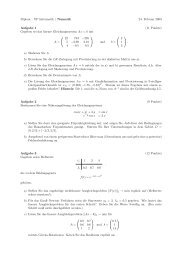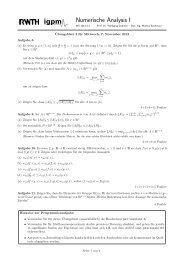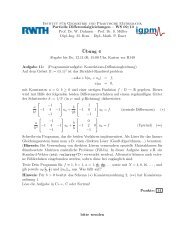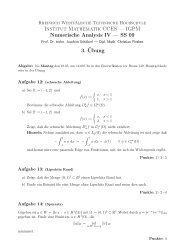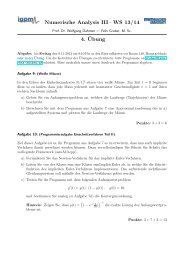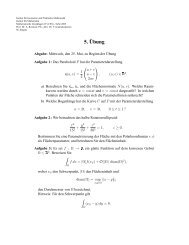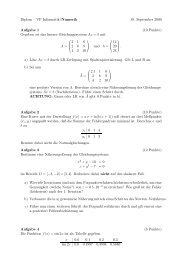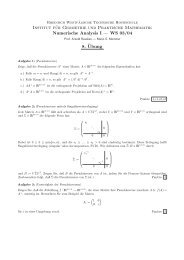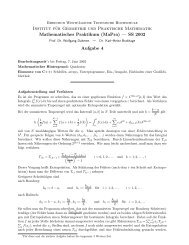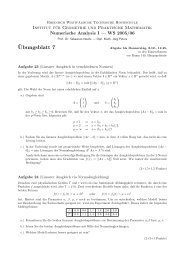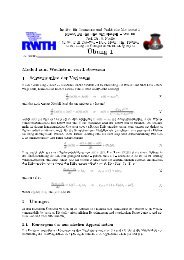preconditioners for linearized discrete compressible euler equations
preconditioners for linearized discrete compressible euler equations
preconditioners for linearized discrete compressible euler equations
Create successful ePaper yourself
Turn your PDF publications into a flip-book with our unique Google optimized e-Paper software.
Bernhard Pollul<br />
Note that in general a smaller timestep will improve the conditioning of the approximate<br />
Jacobian in (6).<br />
We start with an initial coarse grid and an initial CFL number C MIN , which determines<br />
the size of the timestep. After each timestep in the time integration the CFL number (and<br />
thus the timestep) is increased by a constant factor until an a-priori fixed upper bound<br />
C MAX is reached. Time integration is continued until a tolerance criterion <strong>for</strong> the residual<br />
is satisfied. Then a (local) grid refinement is per<strong>for</strong>med and the procedure starts again<br />
with an initial CFL number equal to C MIN . The indicator <strong>for</strong> the local grid refinement<br />
is based on a multiscale analysis using wavelets [10]. In every timestep one approximate<br />
Newton iteration is per<strong>for</strong>med. The resulting linear equation is solved with a user defined<br />
accuracy <strong>for</strong> the relative residual. The approximate Jacobian has a point-block structure<br />
as in the first two test problems: DF(U) = blockmatrix(A i,j ) 0≤i,j≤N with A i,j ∈ R 4×4 <strong>for</strong><br />
all i, j and A i,j ≠ 0 only if i = j or i and j correspond to neighboring cells.<br />
3 POINT-BLOCK-PRECONDITIONERS<br />
In the three test problems described above we have to solve a large sparse linear system.<br />
The matrices in these systems are sparse and have a point-block structure in which the<br />
blocks correspond to the 4 unknowns in each of the N grid points (finite differences) or<br />
N cells (finite volume). Thus we have linear systems of the <strong>for</strong>m<br />
Ax = b , A = blockmatrix(A i,j ) 1≤i,j≤N , A i,j ∈ R 4×4 . (7)<br />
For the type of applications that we consider these problems are often solved by using<br />
a preconditioned Krylov-subspace method. In our numerical experiments we use the<br />
BiCGSTAB method. In the following subsections we describe basic point-block iterative<br />
methods that are used as <strong>preconditioners</strong> in the iterative solver. For the right handside<br />
we use a block representation b = (b 1 , . . ., b N ) T , b i ∈ R 4 , that corresponds to the block<br />
structure of A. The same is done <strong>for</strong> the iterands x k that approximate the solution of<br />
the linear system in (7).<br />
For the description of the <strong>preconditioners</strong> the nonzero pattern P(A) corresponding to<br />
the point-blocks in the matrix A is important:<br />
3.1 Point-block-Gauss-Seidel method<br />
P(A) = { (i, j) | A i,j ≠ 0 } . (8)<br />
The point-block-Gauss-Seidel method (PBGS) is the standard block Gauss-Seidel<br />
method applied to (7). Let x 0 be a given starting vector. Then <strong>for</strong> k ≥ 0 the iterand<br />
x k+1 = (x k+1<br />
1 , . . .,x k+1 )T should satisfy<br />
N<br />
A i,i x k+1<br />
i<br />
∑i−1<br />
= b i −<br />
j=1<br />
A i,j x k+1<br />
j<br />
−<br />
N∑<br />
j=i+1<br />
6<br />
A i,j x k j , i = 1, . . ., N . (9)



